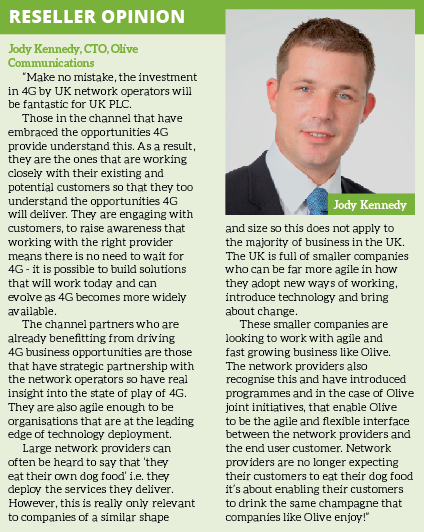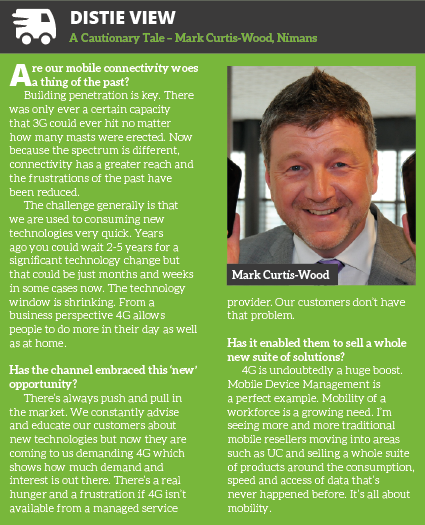
4G was heralded as the rebirth of mobile connectivity when operators first started talking about it years ago. It was going to be far superior to 3G and open doors that only superfast connectivity could open. Cloud technology, M2M and even the way we make calls were all going to change and create a new wave of commercial opportunities for resellers. Here, we take a look at the reality of 4G. Has it delivered all that it promised? David Dungay went to find out!
Depending on whom you talk to 4G access has been hampered for a number of reasons. The real question is has it had an impact on the Channel?
Alexis Argent, Founder and Director of 4Gon Solutions says “The slow roll out has had an impact on the sales of 4G devices, meaning the rise has not been as sharp as originally predicted. However with coverage increasing throughout the UK, we are seeing an improvement in the speeds that users can achieve. I think everyone is still excited, it’s just taken a bit longer than expected.”
 Peter Howsam, Pre-Sales Consultant, Node4 commented “Mobile networking in the business sector continues to be held back by lack of clarity from some of the Mobile Network Operators; complicated tariffs and small print, and too many false promises of speed, coverage and service. Users are more excited about the handset than 4G!
Peter Howsam, Pre-Sales Consultant, Node4 commented “Mobile networking in the business sector continues to be held back by lack of clarity from some of the Mobile Network Operators; complicated tariffs and small print, and too many false promises of speed, coverage and service. Users are more excited about the handset than 4G!
Howsam continues “But generally, where 4G is experienced, both by individual users using smart phones or tablets and by machines (M2M), the results are extremely positive and 4G is delivering what was expected, bringing us significantly superior data services. In the industrial M2M world, 4G connections have opened up some significant new business opportunities.”
4G Promises
4G coverage may be a ‘patchy’ question but are the benefits that 4G promised to bring coming to fruition?
Argent commented “The user experience of 4G is quite variable which reflects the fact that the name “4G” is more a marketing term than a technical standard. Different mobile networks are providing 4G services with very different characteristics in terms of bandwidth and propagation range. This variability reflects the diverse frequency bands in use. An additional factor is the existence of bottlenecks elsewhere in the networks (backhaul capacity etc) and in some locations contention ratios ie. the sheer number of users on a given cell at certain point in time. Also rural coverage remains inconsistent.”
Argent continued “That said, there is no question that the advent of 4G has improved the mobile internet experience for many users with Ofcom tests suggesting download speeds approximately three times those of 3G services on average. It is also clear that all the major mobile network providers are committed to further enhancing service provision and indeed there is currently much industry activity around defining an agreed ‘Quality of Experience’ metric which could be an important lever for ongoing improvement.”
Paul Griffiths, Technical Director, Advanced Technology Group, at Riverbed Technology commented “The fact that carriers were not really ready when the 4G devices (dongles, smartphones and tablets) started shipping indicates that they themselves perhaps expected a delay in the roll-out. Whether it has delivered on its promise is debatable. Today in the UK, the mobile network operators infrastructure is still being updated and as such end-users cannot enjoy quite what the hype promised with 4G. This subsequently means that for the IT support teams of corporate users, it is important to know what applications are suffering and what the geographic location is for the user.”
 Deploying 4G in the Real World
Deploying 4G in the Real World
Peter Howsam clearly disagrees with Ofcom’s version of 4G coverage, he says “The lack of coverage continues to mean that one cannot deploy a solution totally dependent upon a 4G experience, because often the actual service obtained will be 4G with a lot of user contention, or falling back to 3G - with lower data rates - which may not be sufficient.
Never to be beaten, Node4 works around this by deploying multiple 4G carriers in a single device as a private network access technology, especially in sectors such as public WiFi (on transportation), video surveillance and CCTV, as well as using mobile as a primary connection for retail, pop-up and construction sites. Using multiple 4G carriers ensures that 4G coverage is as good as it can be and contention with public users can be overcome.”
Cunliffe commented “There are opportunities in rapid deployments, especially in the Ethernet market. We all know the challenges and delays when installing an Ethernet service. The main problem though, is actually the time it takes to send out the first invoice to start billing the customer. One way to drive this date closer and add more revenue earlier into the partner’s bank account is to deploy a 4G data SIM for temporary access. The service can be up and running within days and even if the connectivity may not be exactly the same as an Ethernet connection, at least the end user is up and running at a decent and workable speed.

Clearly there are still challenges to the 4G rollout and the speed thereof, however if the channel looks close enough there are some tangible and revenue driving opportunities.”
Argent added “4G is proving to be highly effective in the hospitality and temporary outdoor events industry because using G system is much cheaper to install than the fixed line or WiFi alternatives. 4G can also be used by resellers to provide security systems to a site, connecting IP video surveillance systems to a cellular network.
The Channel is beginning to recognise the role that enhanced business class 4G solutions from manufacturers such as i-MO, Teltonika and CradlePoint can provide.”
Paul Griffiths said “While the opportunity for the channel is clear, perhaps better direction as to what to focus on will help partners embrace it. As 4G continues to drive the desire for richer and personalised mobile experiences, seamless connectivity will fast become a top priority for both the mobile network provider as well as for businesses who rely on mobile networks as a means for their employees and customers to access applications and services while on the move. As such, 4G has opened up new revenue opportunities particularly when it comes to visibility and control over the network and these applications. The rise of companies that offer solutions for Mobile Device Management (MDM) is perhaps testimony to some of this growth and indeed this does offer an addition to the Channel partner’s portfolio.”
4G – Important for M2M
While the Channel has still not fully embraced M2M and the Internet of Things (IoT) all indications point to this sector as a great source of revenue. So, how has the rise of 4G coverage impacted this market?
Jon-Paul Clarke, Business Development Director, M2M Communications at Wireless Logic says “4G has definitely been ‘consumer – first’ driven. The impact within the M2M sector. Well surprisingly, it’s not the end of the world as where 4G is prevalent, the 3G spectrum is being freed up. Which does help 4G/3G M2M applications.
4G will be important to M2M. And as for 5G, we feel that there are some solution providers who may skip 4G and head for 5G connectivity… which is possibly closer than we all think.”
Clarke continued “As a final word of caution. 4G has the capability to manage large amounts of data. Big data can mean big bills within the M2M space. So for such connectivity, strict control and monitoring of usage is key. With such applications, it’s vital that protocols and platforms are in place such as Wireless Logic’s SIMPro. Real-time visibility across multiple Mobile Network Operators is key to ensuring no nasty surprises at month end too. For comms players, 4G within the M2M sector is potentially a good business opportunity. ARPU will be greater… but management of the usage/ billing is key.”
Ed Says…
Although Ofcom clearly paint a picture that nearly 90% of the UK premises are covered with 4G from at least one network the Channel doesn’t necessarily share this view. There have been claims from corners of the market that the method for calculating 4G coverage is flawed and relies heavily on data supplied by the carriers. Resellers need to be aware of this and thoroughly check an area before installing a solution which is 4G dependant. Where 4G does work it does open a plethora of opportunities for resellers to get involved and help their customers become more flexible. Temporary connectivity installations which can be later used as back up present an easy to grasp market we see the Channel excelling in.
